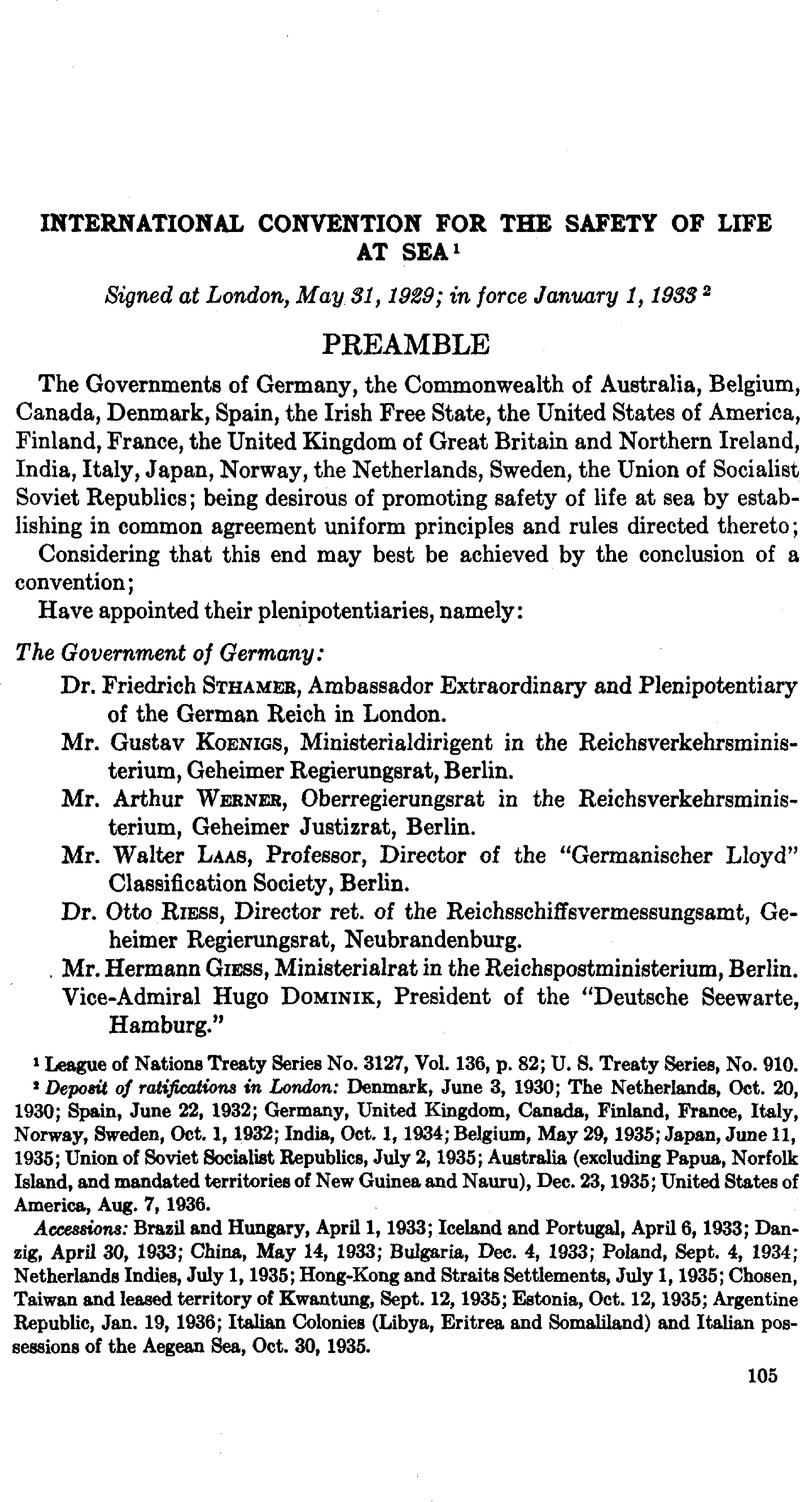Article contents
International Convention for the Safety of Life at Sea1
Published online by Cambridge University Press: 12 April 2017
Abstract

- Type
- Other
- Information
- American Journal of International Law , Volume 31 , Issue S3: Supplement: Official Documents , January 1937 , pp. 105 - 137
- Copyright
- Copyright © American Society of International Law 1937
Footnotes
League of Nations Treaty Series No. 3127, Vol. 136, p. 82; U. S. Treaty Series, No. 910.
References
2 Deposit of ratifications in London: Denmark, June 3, 1930; The Netherlands, Oct. 20,1930; Spain, June 22, 1932; Germany, United Kingdom, Canada, Finland, France, Italy,Norway, Sweden, Oct. 1,1932; India, Oct. 1,1934; Belgium, May 29,1935; Japan, June 11,1935; Union of Soviet Socialist Republics, July 2,1935; Australia (excluding Papua, Norfolk
Island, and mandated territories of New Guinea and Nauru), Dec. 23,1935; United States ofAmerica, Aug. 7,1936.
Accessions: Brazil and Hungary, April 1,1933; Iceland and Portugal, April 6,1933; Danzig,April 30, 1933; China, May 14, 1933; Bulgaria, Dec. 4, 1933; Poland, Sept. 4, 1934; Netherlands Indies, July 1,1935; Hong-Kong and Straits Settlements, July 1,1935; Chosen,Taiwan and leased territory of Kwantung, Sept. 12,1935; Estonia, Oct. 12,1935; Argentine
Republic, Jan. 19, 1936; Italian Colonies (Libya, Eritrea and Somaliland) and Italian possessions of the Aegean Sea, Oct. 30,1935.
3 Omitted from this Supplement. The Regulations are of a technical character relating to construction, life-saving appliances, etc., safety of navigation, and content and forms of certificates.—ED
4 See General Rules relating to Construction and Life-Saving Appliances on ships employed in the carriage of large numbers of unberthcd passengers in special trades, signed at Simla, June 11,1931, by the Governments of Ceylon, Hong-Kong, India, The Netherlands, The Netherlands East Indies, and the Straits Settlements. (League of Nations Treaty Series, Vol. 136, p. 204.) The Simla Rules came into force on the same date asthe convention—ED
5 See footnote 4, supra.
* Unless a more precise and practical method is available to determine the range of transmitters it is recommended that, as a guide, the following relations between the range in nautical miles (from ship to ship under normal conditions in daytime) and the power of the ship transmitter in metre amperes for 500 kilocycles per second (600 m) be used:−
| 100 nautical miles | 60 M A |
| 80 nautical miles | 45 M A |
| 50 nautical miles | 25 M A |
M being the actual height in metres of the aerial from its highest point to the load line.
A being the current in amperes measured at the base of the aerial in case of B, or fully modulated A 2, transmitters. [Footnote in the original.]
6 Omitted from this Supplement. Not in force at date of publication. Annex II isincluded in U. S. Treaty Series, No. 910.—ED.
3 Quoted in Moore on Extradition, Vol. I, pp. 22,23; Moore, Int. Law Dig., Vol. IV, p. 246
4 Moore on Extradition, Vol. I, p. 21.
5 Moore on Extradition, Vol. I, p.50.
- 2
- Cited by




